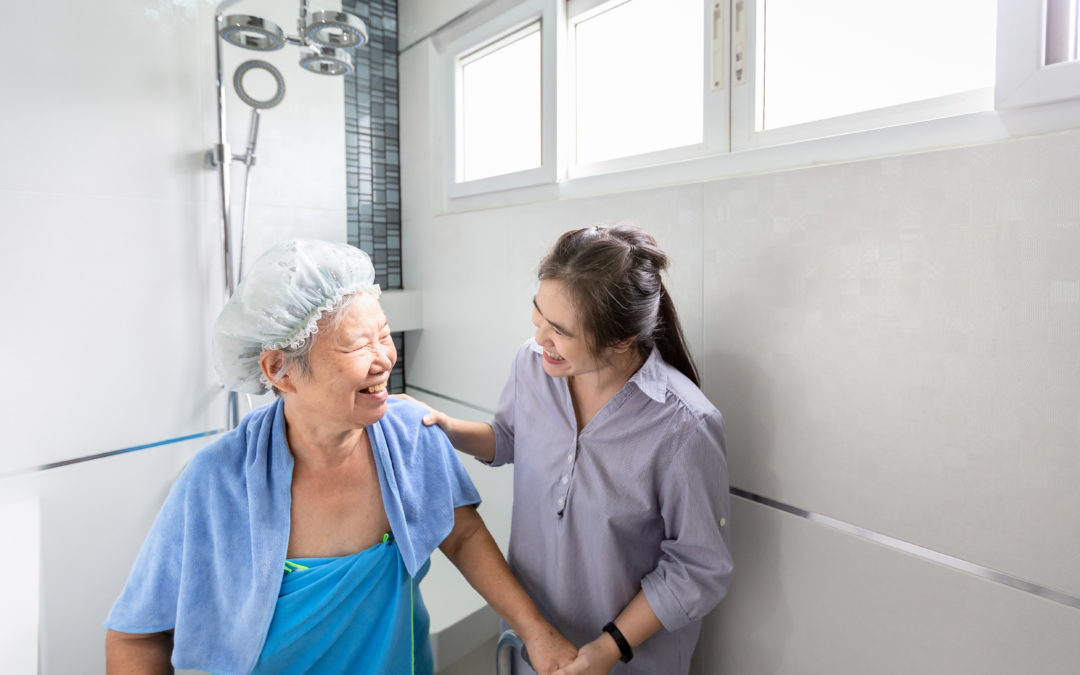
by mobilityplus | 22nd Nov, 2022 | Accessibility
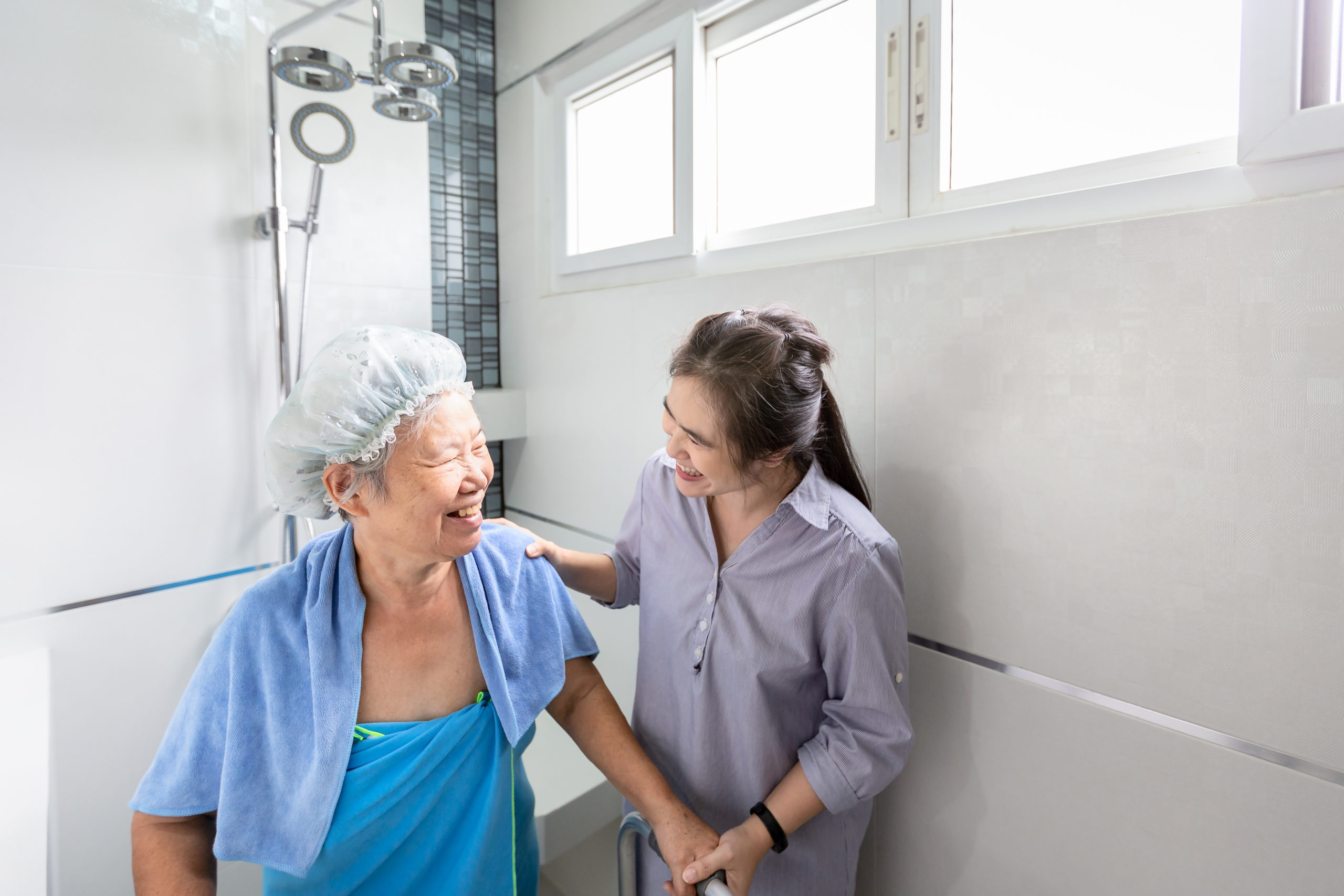
Regardless of your age or any disabilities, you should still enjoy independence in your bathroom, whether using a walk-in shower or bath. For those struggling to get in and out of bath, disabilities and age-related conditions can present challenges, but many bath aids for the elderly and other adaptations can help make life easier.
The bathroom, in particular, is an area of the home with many hazards. But by using the right equipment and being aware of these hazards, you can reduce the risk of harm and support those who need it.
This article looks at simple ways to adapt your bathroom space to provide bath help for the elderly or disabled person. These changes can make your bathroom more functional and enjoyable while maintaining a stylish bathroom space.
Request a Free Brochure
Simply fill out a quick form and see how we can transform the way you bathe.
Request Free Brochure
- Be compassionate and maintain dignity
- Making it easier to use the loo
- Install grab rails where needed
- Make the most of a walk-in bath or walk-in shower
- Use slip-resistant mats
- Use a shower seat
- Adjustable or floating worktops
- Install an emergency pull string
- Provide extra assistance
How to help an elderly or disabled person go to the bathroom and improve the space
When using the bathroom, it’s essential to feel safe and secure. The bathroom is a common place to experience slips, falls and injuries; as such, changes are needed to make the space easy to complete everyday tasks.
The NHS advises on the importance of home adaptations to make your space a safer place for everyone. When considering bathing solutions for the elderly, the changes that are made could be big or small, such as:
- Adding a bath lift
- Using a walk-in shower
- Installing multiple grab rails
- Increasing toilet height
- Widening doorways
Before we jump into what changes you can make to your bathroom, there are a few general housekeeping areas to be aware of. Firstly, ensure the bathroom has been fitted with any necessary bathing aids before the individual needs to use it. Ensure this equipment is up-to-date, working correctly and safe to use. Check the room is warm, the water temperature is correct, everywhere is dry, and all toiletries are within reaching distance.
Now, we’ll cover our top nine tips for providing extra bathroom help for elderly/less-abled family members. Remember, these features aren’t just for convenience—they help your loved one maintain their independence, which is a vital aspect of their overall well-being.
1. Be compassionate and maintain dignity
Even with bathroom aids in place, an individual might still need extra support in the bathroom. Assisting a friend or family member can sometimes be a delicate process, so it’s important to respect their dignity and privacy.
If you need to escort someone elderly to the bathroom, ensure you do so at their pace. Before assisting them with whatever they need to do, be sure to chat them through the process and ask permission to help them. This will make the process much easier and more dignified for all involved.
2. Making it easier to use the loo
A standard-height toilet requires individuals to lower themselves further, which can increase the risk of a fall, especially for those also struggling to get in and out of the bath.
A toilet with a higher seat is an excellent addition to your bathroom to improve mobility. It can give the user greater independence and is ideal for those with limited lower-body mobility.
Even better, the height difference is very subtle so that it won’t affect the appearance of your bathroom. If you care for someone with limited mobility, a raised toilet seat can also help you as a carer. The distance between sitting and standing is significantly reduced, making it easier to transfer the user safely.
3. Install grab rails where needed
Grab rails are among the most popular aids for providing bathroom help for the elderly or disabled. They are simple to install, easy to use, and extremely effective.
They’re simple to install and easy to use while being extremely effective. You can install grab rails wherever they are needed in the bathroom and in any position to suit specific needs. They’re especially handy in small bathroom layouts.
A common spot is above the bath, making it easier to get in and out of the tub or shower. Even better, they come in various designs, so you can place one in your bathroom without spoiling the look or decor.
4. Make the most of a walk-in bath or walk-in shower
A walk-in bath or shower pod is a must-have addition to your accessibility bathroom if you’re looking for the best mobility aids. This is a permanent solution to making bathing experiences more accessible and safer.
Walk-in showers or wet rooms are designed to be accessed with ease and feature built-in support such as:
- Grab rails
- Easy temperature controls
- Non-trip shower trays
- More space
The low or no-threshold shower tray makes getting in and out of the shower much safer and more accessible. This is ideal for users with low mobility who still want to maintain their independence when it comes to showering.
A walk-in bath may be more suited to your needs or preferences. These are designed to make the bathing experience safer and more enjoyable for those with a disability or low mobility. Features include:
- Non-slip flooring
- Easy entry point such as low entry doors
- Seating for bathing
- Easy temperature control
Many designs are also stylish and modern, featuring chromotherapy and spa therapy options to make the experience all the more luxurious.
Alternatively, if you don’t want to make such a permanent change to your bathroom but still want to create an accessible bathing experience, you could consider a bath lift. This powered seating device is attached to your bathtub to lower and elevate the user in and out of the tub. They can be used independently or are commonly used to assist carers in helping someone with limited mobility access the bath safely.
5. Use slip-resistant mats
Bathrooms are inevitably slippy, and one of the best and most affordable ways to aid an elderly or disabled person in the bathroom is by using slip-resistant mats. These suctioned rubber mats can be used in the bathtub, shower tray or bathroom floor to provide friction and reduce the chance of slipping. The individuals can then move around the bathroom with more security.
6. Use a shower seat
Shower seats are a no-brainer to improve the safety of the shower area. A foldable seat can be used if your shower is on the smaller side, or you can install a fixed shower seat which allows the user to sit before washing comfortably and securely.
Not only are you taking the weight off your feet, but for those with limited lower mobility, these seats are a game changer to continue enjoying the showering experience. Shower seats are beneficial aids for wheelchair users as they allow for easier access and transfer into the shower.
7. Adjustable or floating worktops
If someone struggles to reach inside a basin, it makes the simple task of washing your hands or face difficult, which can decrease personal hygiene. For example, a wheelchair user needs to get right up to the sink or worktop to be able to use it. The best solution, in this case, is to replace your cabinets or standard sink area with a floating sink or a height-adjustable model.
Floating basins are as simple as they sound. The sink unit is floating with free space all the way to the floor, which allows you to fit a wheelchair comfortably underneath. This is also beneficial for a carer supporting the elderly person, as two people can fit more comfortably into the space.
Another option is to use height-adjustable sinks or worktops that allow you to move the basin to your desired height every time you use it. This is an effective bathroom aid for people with restricted growth, and thanks to its adjustable nature, it doesn’t affect your bathroom decor.
8. Install an emergency pull string
A must-have bathroom aid for any elderly or disabled person is an emergency pull string. These are strategically placed cords that provide an easy and fast way to call for assistance. They’re ideal for bathrooms as you’re unlikely to be wearing a personal form of contact while in the bath or shower.
Once pulled, it will send a signal to caregivers, who can then come to help. This is not only an effective way of keeping the user safe in times of danger, but it can also help to maintain some form of independence too. The individual can be supported as and when they feel they need it but otherwise left alone to complete their everyday bathroom tasks.
9. Provide extra assistance
Some of the most useful bathroom aids are the simplest of all. In some cases, these are the finishing touches that will help the user maintain their independence and use the bathroom alone. Examples could include:
- Reaching aids: These are long pieces of equipment that have gripping jaws on one end and a handle on the other. Once the trigger is squeezed, you can pick up items in the bathroom, such as towels and clothing, without having to overreach and risk falling.
- Tap-turner: These nifty accessories are useful for twisting taps without needing much strength – ideal for those with reduced strength.
- Temperature controls: Easy-to-use temperature controls allow you to control the temperature of your bath or shower with ease. They’re designed in a way that you don’t have to worry about knocking them, and you can focus on manoeuvring safely instead.
In some cases, it may get to the point where physical bathroom aids aren’t enough alone, and your loved one requires extra assistance. At this time, it’s best to employ a carer or train yourself adequately to support the individual.
It’s time to safety-proof your bathroom
You may choose to make quick fixes to your bathroom, such as installing grab rails and slip-resistant mats, or you may opt to make more permanent changes, such as purchasing a walk-in shower or bath. Either way, finding a way to make your bathroom space suitable for elderly and disabled people is important to ensure a confident, comfortable and safe experience.
At Mobility Plus, we specialise in creating an experience that suits your personal needs. Our wide range of walk-in showers and walk-in baths have the very best built-in features to make your bathroom secure while maintaining style too. If you want to talk more about this subject or need advice, please don’t hesitate to get in touch with our friendly team.
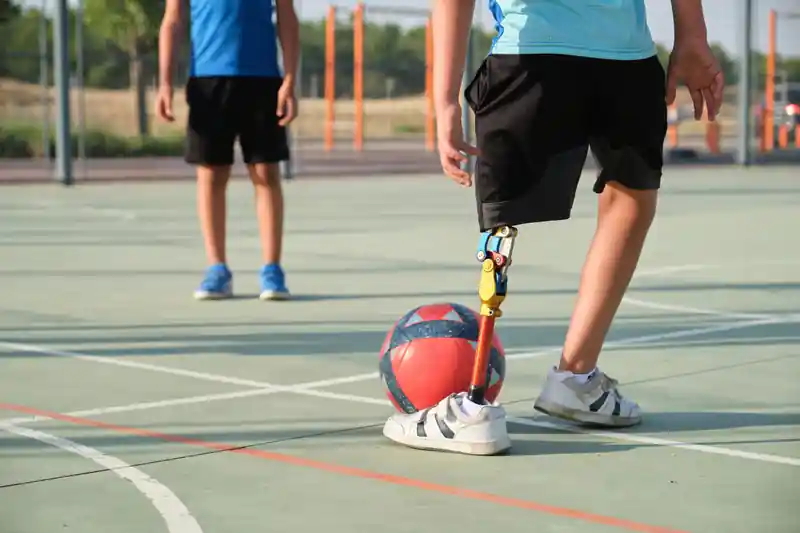
by mobilityplus | 24th Sep, 2021 | Accessibility

If you followed sport over the summer of 2021, you may have been feeling inspired by the success of Team GB at the Paralympics. From Kadeena Cox’s phenomenal wins in para-cycling to Chris Skelley’s judo victory, there were some truly impressive, world-class performances throughout the competition.
However, disability sport means more than just the Paralympics and Invictus Games – there is also the Special Olympics for elite athletes with a learning disability.
And, better yet, there are a whole range of ways that any disabled person can get involved in sport – whether they want to progress to a competitive level or just enjoy the experience.
What’s in this article:
- The benefits of sport for disabled people
- How to get involved in disability sports
- How to increase participation in sport for disabled people
- Adaptive and inclusive sports for disabled people
The benefits of sport for disabled people
As with anyone, participating in sport can offer huge benefits for disabled people.
In addition to the universal products of exercise, such as physical fitness, flexibility, bone health, there can also be impacts that can be of particular benefit to disabled people – whether that’s managing a chronic physical condition or building confidence among individuals with learning disabilities.
Research has found that disabled people are four times as likely to feel chronically lonely, and sport can provide a fantastic opportunity to reduce social isolation and get involved in the local community.
Being active can also boost serotonin (the ‘happy’ chemical), help individuals to make friends and develop skills such as leadership, which can be vital particularly for young people entering the workplace.
How to get involved in disability sports
If you identify as disabled and would like to get more involved in sport, now is a great time to start your journey.
There are now more opportunities for disabled people of all ages and impairments to be active than ever before – you just need to know where to start.
So, here are a few pointers to get you started…
1. Find a local inclusive sport club
One of the best ways to get involved in disability sport is to look for a local community group that offers sports sessions for disabled people – or that is inclusive of all requirements.
You are bound to be welcomed with open arms: did you know that according to research by the Activity Alliance, 73 percent of non-disabled people say they are open to taking part in sport with disabled people?
Contact your local council to enquire about relevant opportunities, or visit the Parasport website, where you can simply enter your postcode and find a directory of clubs, sessions and facilities near you.
2. Look for inclusive versions of your favourite sport
Did you once play a sport, but had to stop due to a health condition? Or is there one particular sport that you’ve always wanted to try?
If so, the best place to start is to look up inclusive or adaptive provisions in your chosen sport.
For example, if you know you love netball, a good first port of call could be to contact the National Governing Body for the sport (in this case, England Netball if you are in England).
With a simple enquiry, any NGB will be able to direct you towards a group or session that will be able to cater to your requirements, and where you can experience the joys of your favourite sport.
3. Go online!
If you can’t find a sports session in your area that you would like to get involved with, fear not!
The Internet is an endless resource of activities, and you are guaranteed to find something you fancy trying, whether it’s an inclusive Zumba video on YouTube or a live adaptive sport Zoom session.
Disability Sports Coach, an inclusive sport charity based in London, runs several online inclusive sport sessions each week, from dance to boxing. They have also created a PDF resource called Active At Home, which provides fun, accessible exercises that you can try any time at home, with a range of adaptations for different impairments and needs.
How to increase participation in sport for disabled people
Unfortunately, whilst playing sport can reap significant benefits for disabled people, many face difficulties in participating in physical activity.
In fact, Sport England’s Active Lives Adult Survey found that disabled people in the UK are almost twice as likely to be physically inactive (43%), than non-disabled people (23%)
The good news, however, is that there is a real desire among disabled people to engage in sport more often.
According to the Activity Alliance’s Annual Disability and Activity Survey 2019-20, 81% of disabled people would like to be more active.
So, what’s the solution?
Well, the answer is varied. In the aforementioned survey, only two in five disabled respondents said they feel they are given the opportunity to be as active as they would like to be.
Catalysts of opportunity could be venues with accessible features such as wheelchair ramps, seated alternatives to activities, or affordable inclusive lessons in the local area.
Understanding barriers to participation
Whilst there are various approaches to increasing participation in sport among disabled people, at the foundation of every attempt to promote inclusion needs to be an understanding of the barriers that prevent disabled people from participating in the first place.
It isn’t just an individual’s impairment or condition that is a barrier to their involvement in sport – in fact, if we follow the social model of disability, we can see that it is actually society’s lack of provision for the full spectrum of needs that is the ‘disabling’ factor.
A wide range of deep-seated structural inequalities are at play in preventing equal access to sport, ranging from lack of social provisions and education to transport issues and economic barriers.
Did you know, for example, that a disabled person faces on average an additional £583 every month just for their cost of living?
Being aware of these barriers will allow us to appropriately focus our efforts on areas of need and tackle inequalities from the root.
Acknowledging diverse experiences
Another key factor in increasing participation for disabled people in sport is understanding the diversity of experiences among the community.
The term ‘disabled’ covers a very broad range of conditions, from physical impairments to learning disabilities and more.
In addition, there are a range of intersecting aspects of lived experience that can compound or influence how each person will interact with sport.
For example, it is widely acknowledged in research that women are less likely to be active than men – meaning that disabled women may face additional challenges in becoming active.
These details are all important to acknowledge when developing interventions to support disabled people to be more active, because what might help one person get involved will be very different to another.
If we commit to learning about this diversity of experience, we can avoid creating a one-size-fits all solution that fails to adequately address unique needs.
Tackling challenges collaboratively
When we come to the stage of building solutions, collaboration is key.
All too often, individuals and organisations respond to issues they care about by immediately creating programmes or projects – which is fantastic, and comes from all the right places – but can sometimes replicate already-existing efforts, resulting in a disjointed array of services.
The key thing here is collaboration – the more that organisations can work together to pool expertise, insight and resources, the more coherent – and, often, effective – the result.
So, whether you’re an individual with a knowledge of sport who would like to help disabled people get involved, or an organisation in the disability space looking to expand your work into physical activity provision, seek existing services in your area to partner with.
This way you will be able to reach more people and create an impactful, integrated solution to support disabled people to engage in sport.
Listening to disabled people’s experiences
At the very centre of all of these considerations is one thing: lived experience.
If we are not building ways to get disabled people active based on their own experiences – their challenges, aims and desires, then we are never truly going to know which areas are most pressing to address – or how the participants themselves will best engage with the sports provided.
So, we need to reach out to community networks of disabled people and ask them to share their experiences – find out what prevents them personally from engaging with sport as much as they would like to; to ask them which sports they are interested in trying, and what would help them to do so.
This is the essential building block to put in place when attempting to increase participation in sport for disabled people.
Creating safe spaces for disabled people in sport
Of course, above all of this, the most important step in helping disabled people to participate in sport is simply ensuring individuals feel welcome, safe and supported.
Creating welcoming spaces is about more than just inviting disabled people to sport sessions, it’s also about allowing the space for individuals to express their unique and sometimes changing needs, enjoy sport without fear of judgement, and provide feedback.
We all want to feel seen, heard and accepted – and this is all the more important for disabled people who so often face exclusion.
Coaches should be trained to let participants take activities at their own pace and make alterations to allow for continued enjoyment should any hurdles become apparent.
The more dynamic sports leaders can be in responding to a wide range of requirements, the easier it will be to make disabled people feel included – and encourage them to keep engaging.
Ultimately, the most effective way to get as many disabled people involved in sport is to offer a range of both adaptive and inclusive activities at all levels of expertise, from beginners grassroots sessions to competitive tournaments. However, this requires…
Investment in disability sports
You guessed it. Creating accessible facilities, adaptive sports equipment, inclusive activity programmes and more requires funding, and so for any of this to happen, investment is paramount.
And, considering that research has found every £1 of investment in grassroots sport yields £3 of social and economic benefit, it makes sense to invest in sports opportunities for the 43% of the 14.1 million disabled people who are currently inactive.
This August, the Government released their new National Disability Strategy, which promised to be “the single greatest focus and collaboration across government” in disability equality the UK has ever seen.
The Strategy promises wide-reaching investment in inclusive sport for disabled people, but many organisations feel we need to do more.
In a statement responding to the Strategy’s publication, Disability Sports Coach CEO, Peter Ackred, said, “it is clear that wide-reaching changes are needed in order to achieve social justice for disabled people.
However, this will require increased funding and an integrated effort across Government departments to support the organisations best placed to identify and tackle the barriers disabled people face.”
Adaptive and inclusive sports for disabled people
Generally-speaking, disability sports fall into two categories: adaptive and inclusive. Adaptive sports are those that have been designed with a particular group of participants in mind, whether that is for a specific physical impairment or learning disability.
A sport could be made adaptive by modifications to equipment, rules, structure, support, environment and many other factors. Adaptive sports include wheelchair basketball, seated bowling, blade racing, modified cycling and many more.
Inclusive sports, on the other hand, are designed so that disabled and non-disabled participants can play together, meaning that everything from facilities to equipment and programme content need to be appropriate for the broadest spectrum of people. Inclusive sports include Boccia, new age kurling, handball and others.
According to the Activity Alliance’s Disabled People’s Lifestyle Survey 2013, two thirds (64 per cent) of disabled people would prefer to take part in inclusive sport – playing with both disabled and non-disabled people.
However, these preferences will depend on various factors, including which sport individuals want to play, to what level of skill and in what kind of environment.
For more information on helping to increase participation in sport for disabled people, Sport England have published a guide, Mapping Disability, which provides a range of support, from explaining appropriate terminology to how to structure sessions for inclusivity.
—
The Paralympics is always an exciting moment in the sporting calendar. But disabled sport should be celebrated – and accessible – all year round. The opportunity to enjoy movement is just as fundamental to our daily lives as the ability to bathe safely and comfortably, or go shopping independently.
So, let’s all spread the word about the importance of inclusive sport, so more people can enjoy its benefits every day!
Resources: Sport England, Activity Alliance, Parasport, We Are Undefeatable, Disability Sports Coach
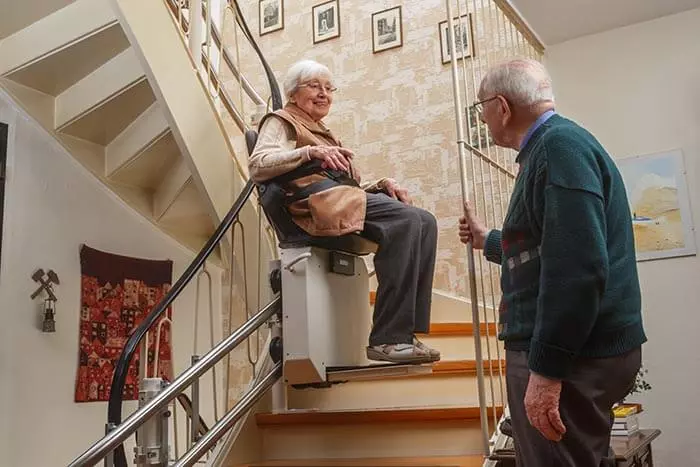
by mobilityplus | 18th Jun, 2021 | Accessibility

There are 14.1 million people with a disability living in the UK. These figures take into account a broad spectrum of conditions that are classified as a disability which can require a variety of different adjustments to make a space more accessible. But, what is often common among the varied conditions experienced, is that accommodations make living with a disability easier for those people. From ensuring environments account for accessibility to providing safety features and enhancements, there are lots of ways we can make our homes more disability-friendly.
Depending on the type of disability or mobility concern you or your loved one is experiencing there are a multitude of ways that homes can be adapted to make them a more welcoming space. From a little help in the kitchen or bathroom which are considered high-risk areas for slips and falls, to making a property wheelchair accessible, we’re going to review how to make your home more accessible.
- Provide ramps instead of steps
Whether you or someone you live with uses a wheelchair or has mobility issues, swapping out stairs for a ramp is one of the best ways to make your home more disability-friendly. If you can’t completely renovate your property to exchange your stairs for a ramp, consider whether you can use temporary measures.
Like a portable ramp or if wheelchair access isn’t required, evaluate how you can make the stairs more accessible – such as by adding non-slip surfaces and handrails for extra support. Before you start any work on installing a ramp, you will need to check what permissions are required for any work completed on your home, as well as what will be possible with your current fit-out.
- Widen doorways to create more space
Space can be one of the biggest barriers when it comes to accessibility in the home. To make your house more disability-friendly, consider widening doorways to accommodate the additional width of a wheelchair or walker. With many British homes being hundreds of years old, they tend to be built narrower than modern homes.
Broadening the width of your doorway can be a costly process. You may need to ask what changes you can make to your property if there are restrictions or covenants in place before you undertake any work.
- Consider automatic doors
While not as common, you can look to install automatic doors in your house. While these are more commonly used in commercial buildings, they can be particularly useful for those in a wheelchair. Giving the option of greater accessibility by removing the need to try to open doors, this may be an option you wish to consider.
Request a Free Brochure
Simply fill out a quick form and see how we can transform the way you bathe.
Request Free Brochure
- Install a stairlift if you have a multi-storey property
A lot of British homes are multi-storey, which means stairs are an inevitable part of your living experience. If you or someone living in your home is a wheelchair user or has mobility issues that make stairs an impossibility, a stairlift is a modification worth considering for your home.
Stairs pose a problem for many people who experience mobility issues, so installing a stairlift can make a huge difference to the quality of your living space. Stairlifts are available in both permanent and on-the-go solutions that provide flexibility depending on your circumstances. So long as you can transfer in and out of a wheelchair, a stairlift is a wonderful addition to make your home more accessible.
- Handrails on both sides of the staircase
If you or your loved one can still access and use stairs but requires a little additional support, then adding another handrail could be all you need. By offering support on both sides, it can increase the safety of using stairs in your home. It’s worthwhile extending the handrail beyond the first and last stair. This will enable residents to secure their grip before approaching the stairs and is particularly useful for those with visual impairments, as it offers support before walking on an uneven surface.
- Replace carpets with wooden floors
Whether someone in your home is using a wheelchair or has other mobility-related concerns, switching out your carpeted floors for wooden flooring can make moving around the home much easier. Carpets, especially those with a deeper pile, can prevent wheels from moving freely, obstruct or catch walkers, or cause trip hazards for people that may have trouble lifting their feet higher off the ground. Changing your flooring is a moderately affordable change to your home that can be done fairly quickly and has a big impact. Likewise, large rugs can also be an issue, particularly posing a trip hazard as the rug isn’t affixed to the flooring.
- Adjust the height of worktops
Adjusting the height of worktops can be a big job when adapting your home to be more disability-friendly. However, if you or someone you live with uses a wheelchair, this can make an enormous difference to the accessibility of the home. There are two options that you can consider when reviewing the height of your worktops. The first is to completely adapt the height so that most or all of the space is wheelchair accessible, which will involve lowering the height overall.
If this isn’t suitable, you may want to consider adjustable height worktops which allows you to adapt the height based on the needs of the user. This is especially useful if there are multiple users in the house, but not all require the same height. Adjusting the height of your worktops doesn’t only benefit wheelchair users. Those who may be unable to stand for long periods but want to use the kitchen can also make use of the lower level bench tops by using a seat to support them when cooking, preparing meals or washing up.
- Consider smart home installations such as blinds, lighting and TV
Smart home installations are a newer solution on the market, but they can have a big impact on improving the accessibility of a home. Blinds, lighting and TV controls that can either be managed from an app or panel can provide more autonomy for users and may require fewer changes to your household overall in the long term.
- Add grab bars in the bathroom
Grab bars are a fast and easy way to make your home more disability-friendly without costing you a lot of money or taking a long time to install. A quick and easy process that helps to turn your bathroom into a disability bathroom, grab bars offer additional support. Particularly useful for those who need a little extra confidence in high-slip locations such as tiled areas, they can make showering and using the toilet considerably easier.
Grab bars can be added to the shower to prevent slips and falls on slippery floors while also adding a balancing aid for people who experience mobility issues. Similar to wall grab bars, a frame can be installed around your toilet to provide additional support when sitting and standing – this can be beneficial for people who have mobility or strength-related disabilities or be added as a more temporary installation for those with injuries such as someone who is using crutches.
- Flip down shower chair
Not everyone can stand in the shower, which is why the addition of a flip-down shower chair can be a wonderful addition to your home. If you don’t have a bath, a flip-down shower chair can be used to provide waterproof seating for people who are unable to stand for long periods – such as for the length of a shower. Installing a flip-down design means the seat is secured to the wall, making it less hazardous than a freestanding chair which could tip, and it can be neatly stowed away when other members of the household are using the shower.
- Consider a walk-in shower
A walk-in shower is a great way to make your bathroom more disability-friendly. By removing the barriers of stepping into a shower, such as with a shower-over-bath design, trip and slip hazards are minimised. People with mobility issues or wheelchair users can access the shower with ease. Walk-in showers, sometimes known as level-access showers, don’t have a high tray either, making them a highly beneficial consideration when reviewing improvements to make to your home.
Walk-in showers also feature a range of other benefits that increase their appeal for a disability-friendly home, including the ability to add a foldable shower chair, support handrails, non-slip flooring to reduce slip risk, an easy temperature control system and the enclosures are easy to clean.
- Discover the benefits of a walk-in bath
Like a walk-in shower, a walk-in bath is an ideal consideration to make your home more accessible for disabled users. Designed to promote a safe and relaxing bathing environment, walk-in baths have watertight doors, allowing people to get into and out of the bathtub without having to lower themselves down into it. They’re usually compact and can be made so that the person sits up while bathing, but there are also more traditional walk-in baths that are full-length, allowing the person to lie down to enjoy their bathing.
Users can choose to have a walk-in bath with a lift that goes one step further and helps the person into the bath without them having to step through the door itself. Non-slip flooring, easy temperature controls and grab rails also make a walk-in bath a great choice for making your home more disability-friendly.
- Change doorknobs and tap fittings
There are many disabilities that affect a person’s dexterity which means using doorknobs and certain tap fittings can be a difficult task. Instead of a doorknob that is round and requires a firm grip around to turn, switch them for lever-style handles that can be pulled down and don’t require a tightened grip. The same applies to tap fittings. Rather than designs that require a turning motion, opt for lever designs that need less strength and give the user a greater space to pull to use the tap.
- Two-way switches
Two-way switches are convenient and increase safety in your home, making them the perfect addition to make your living space more disability-friendly. By installing switches at the entry point and near the bed for example, users can move from one area of the space to another without the risk of visibility issues. By providing dual-access points for power, particularly lighting, residents can also benefit. Whether someone is bedridden and needs to access to lighting from bed, those on crutches can move around without fear of tripping or wheelchair users can confidently move around without having to feel their way through the dark. Two-way switches are a small but mighty change that will improve the experience for everyone in the home.
- Review furniture placement
Furniture can become an obstacle for those with mobility concerns or those using a wheelchair to navigate their way around the home. Careful consideration of furniture placement can make a space significantly more liveable for those with disabilities. Keeping thoroughfares clear of furniture, avoiding pokey spaces that need to be accessed and ensuring there are no tight turns or sharp corners will make your home much more accessible for users. Also ensure you keep everyday items like utensils and serving ware, books and remote controls in easy-to-reach places, so they can be accessed quickly and without any barriers.
Making your home more accessible can include a range of adaptations from minor adjustments to larger renovations. The changes you consider will depend on the type of disability you are accommodating your living space for, and your budget. By creating a more disability-friendly home, it will ensure it becomes a space to relax and feel safe while nurturing a welcoming and enjoyable environment.
Whether you choose to add small touches because you’re renting a property or updating your forever home to accommodate your needs, these tips should help inspire you. Let us know which features you’ve made in your home to foster a more disability-friendly space.
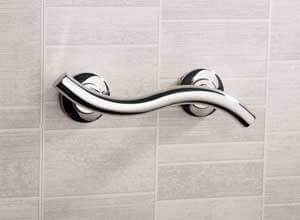
by mobilityplus | 26th Apr, 2021 | Accessibility
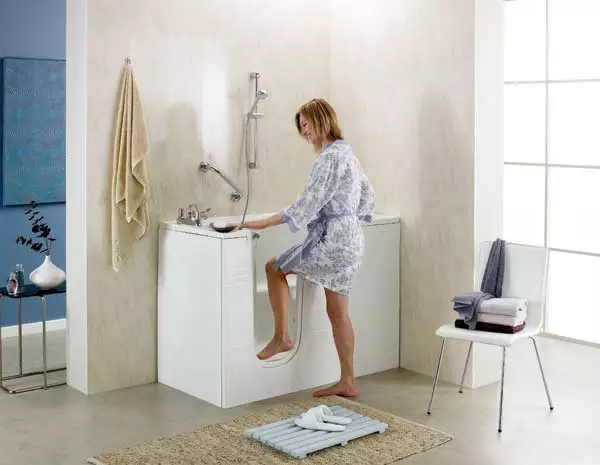
Do you have an upcoming surgery or have you recently undergone an operation? There are a few key aids that can help make your recovery much easier at home. Depending on the nature of your procedure, your postoperative care can be wide and varied. However, as we know, avoiding unnecessary stress can do the world of good when it comes to the healing and recovery process.
To ensure your home is both comfortable and accessible once you return from the hospital, it’s important to consider what you might need to support your postoperative care. While your doctor will supply a set of instructions to help you best support your recovery, likely including a list of activities you can and cannot undertake, there are additional tools and aids that you can benefit from.
One thing you certainly want to avoid is any slips or falls that could impede your recovery. Around one-third of people aged 65 and over, and half of those aged 80 or over fall at least once a year. In 2017-2018, the NHS reported there were more than 220,000 fall-related incidents in the over 65 age group annually. Putting measures in place to avoid this can be incredibly important. Many of the aids that will help you avoid slips around the home will also be ideal for post-operation care, especially if your mobility has been impacted due to your surgery.
Taking into consideration everything from small items and useful tools to upgrades in the home, here is a list of the best aids to consider after you’ve had an operation.
- Walk-in shower
Walk-in showers are a great way to create a disability-friendly bathroom, especially after you’ve had an operation. Not only are they ideal for anyone who experiences mobility issues, but they also remove the need to step into traditional shower-over-bath designs that can be difficult to manage post-operation. Installing a walk-in shower minimises the risk of slipping, reduces the need for unnecessary strain on any wounds or joints that are healing and will be a worthwhile long term investment.
Available both with doors or without for easy wheelchair access, walk-in showers also come with a range of safety features included as standard such as non-slip flooring, ultra-low threshold and an easy to clean enclosure. These are all ideal features for post-operation environments.
- Walk-in bath
If standing is of concern, or perhaps you simply prefer baths, a walk-in bath can be a great investment. Designed to remove the need to step over the side of the bath, walk-in baths minimise the risk of bathroom falls and improve accessibility for users.
An access point is cut into the side of the bath meaning you can easily step directly into the tub. Including a side door for easier access, there are a number of other key safety features including; non-slip surfaces, support bars, low entry doors and easy temperature control.
- Shower chairs
Whether you are unable to stand in the shower due to the nature of your operation or need additional support while you are healing, a shower chair is an effective and affordable aid to support your recovery at home. If your operation involves any part of your body below the waist, a shower seat will be a welcome addition to your bathroom while you rest up and recover.
Shower seats are most suitable for walk-in showers as the curved edges of a bath won’t provide a sturdy and level surface that the chair requires. Shower chairs are designed with holes to allow the water to drain and rubber ends on the legs to ensure the chair doesn’t slip.
There are chairs available for use in the bathtub that are compatible with the curved sides and transfer benches are another alternative for people who use a wheelchair. Available in padded options for additional comfort, these are all great solutions for assisting post-operation and are ideal for short- or long-term use.
- Handheld shower heads
Some options might mean you need to avoid getting your healing wound wet, which means you need increased control when showering. A handheld shower head increases flexibility if you have limited mobility after your operation but will also enable you to avoid getting certain areas damp. While a fixed position shower head will cause restrictions and may limit whether you can even use your shower, a handheld version gives you a lot more control over the situation.
- Grab rails
If you need additional support when moving around your home after an operation, grab rails are a fantastic aid for your bathroom to help you stay steady on your feet. Textured models provide extra grip and are particularly useful where wet surfaces are concerned, such as in the bathroom. They will help support you if you have mobility or strength-related issues after an operation.
Grab rails can be used on walls and in the shower as well as in your bathtubs. Adjustable options have the ability to clamp onto the side of the bath and the height can be adjusted to suit your needs. Another option in a similar concept to grab rails are toilet surrounds. Instead of single wall-mounted rails, they are a frame that surrounds the entire toilet and provides sturdy support to help people as they sit and stand.
- Raised toilet seats
You’ve probably realised that there is no standard height for toilets, while some are high others might be set quite low. This can cause issues for people who are recovering from surgery, experience mobility issues or need additional support when sitting and standing.
Raised toilet seats help to add height by sitting on top of the regular seat to make it more accessible. If you have had a hip or knee replacement, these will likely be very useful aids to temporarily add to your home while you are healing after your operation.
- Wheelchairs
A huge benefit for anyone whose mobility is affected by their operation, a wheelchair is a common and highly sought after aid for those who have had a range of surgeries including hip and knee replacements. When you’re unable to walk while you are letting your body heal, a wheelchair will help you get around, whether at home or out and about.
- Crutches
If you’ve had any sort of surgery on your feet, ankles, knees or legs crutches will be a huge help once you’re at home in recovery. Supporting you, so you can keep the weight off, they’ll make moving around easier.
- Portable walking cane – stool combo
In a similar vein to crutches, the added support of a walking cane will be a huge help when trying to ease weight-bearing. Even better than just a standard walking cane though is the option of a cane and stool combo. These give you not only the support to avoid weight-bearing on recovering post-operative wounds but also enables you a place to sit if you require it. Easy to fold from a stool into a cane to give you that little bit of additional support it’s a two-in-one item that is easy to store and use when needed.
- Stairlifts
If you’ve been required to use a wheelchair after your operation, a stairlift might prove useful if you need to access various levels within your home. By eliminating the need to walk up and downstairs, it can help you move between the levels of your house with ease and without causing unnecessary stress on your body while you are recovering.
- Reachers
Reachers or grabbing tools are a brilliant aid to help you make life at home easier post-operation. Whether you can’t bend like you normally would or can’t stretch to reach things stored in higher places, a reacher can help you access items. From dropped items to books on the top shelf, this useful tool acts as an extension of your arm so you can avoid bending, stretching and reaching when you don’t need to.
- Home massage devices
If permitted by your healthcare practitioner, you may be able to reduce aches and pains with a home massage device. Sometimes, when we are healing from an operation, we compensate by overusing other muscles and joints to ease our use of the affected area. This can result in increased discomfort elsewhere on your body. If allowed and safe, a gentle massage device could help you avoid additional discomfort while you rest and recover.
There is nothing more important than rest and relaxation to support your recovery post-operation. By introducing useful tools and aids to support you around the home and when out and about, you can make the process easier on yourself. Whether it’s installing grab rails in your bathroom, using a reacher so you don’t pull your stitches, or upgrading your bathroom so you can benefit long term from easier access with a walk-in shower or walk-in bath, there’s a range of beneficial aids available to you post-operation.
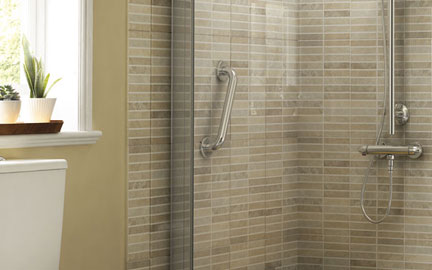
by mobilityplus | 27th Sep, 2018 | Accessibility
Your bathroom may be the place you go to relax and unwind, but statistically it’s also one of the most dangerous rooms in the home.
Sleek surfaces may make cleaning that much easier, but they also act as potential slip hazard. Throw water into the equation and the risks are further increased, particularly for those with mobility issues.
As suppliers of walk-in showers, walk-in baths and wet rooms, here at Mobility Plus we’ve put together some ideas about how you can make your bathroom safer for you and your guests.
Grab rails

Easy to install and offering vital support in potential danger-zones, grab rails are something no bathroom should be without. We recommend that they are correctly fixed to the wall with screws, as they are far less likely to come away at the wrong moment. It’s also worth checking that the rails you buy are appropriate for the weight of the person using them.
Grab rails are most-often installed in showers. We recommend those with textured grips for extra purchase in a wet environment such as level access walk-in showers. However, if you don’t have a shower, we also supply a range of grab rails for baths, giving those with mobility issues extra security when getting in and out.
Bathroom furniture
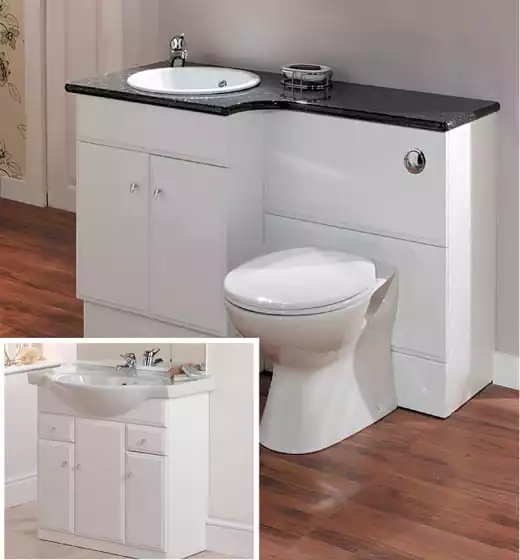
High-pan toilets can make life much easier for those with mobility issues. The extra height makes it much easier to get on and off the toilet and is particularly helpful to wheelchair users.
However, if you do install a high-pan toilet, be sure to move your loo-roll holder to an accessible place that doesn’t require the user to twist or stretch. In the event that there’s no wall space available, a freestanding holder is easier to reach than one that’s fixed in an inconvenient location.
Shower seats are another indispensable piece of bathroom furniture. These can be fixed in place, or you can choose from pull-down options to maximise space.
Non-slip surfaces
Many bathrooms have smooth, tiled floors, which become dangerously slippery when wet. We offer a range of bathroom flooring that offers all the aesthetics of standard bathroom flooring, but with subtle texturing to provide extra traction.
Non-slip mats are a good alternative, offering islands of safety. However, for floor-to-wall safety, non-slip bathroom flooring is the better option.
Showers
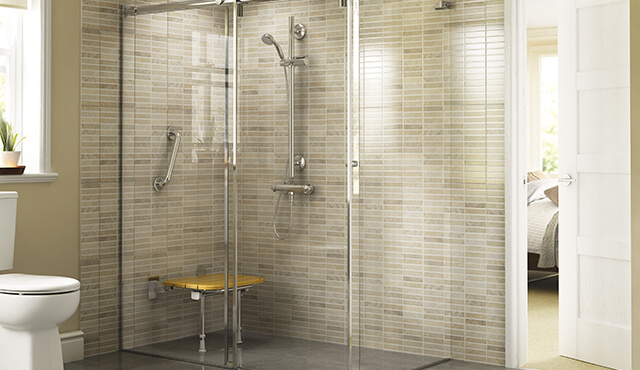
While many people are aware of the benefits of walk-in showers, the shower units themselves are often overlooked. At Mobility Plus, we offer a comprehensive range of showers, designed especially for those with disabilities or mobility problems such as showers with bi-fold doors and affordable walk-in showers. Thermostatic mixing showers are a superb way to prevent scalding. Mixing cold water with hot, they can be set to a specific temperature, ensuring that it is the same every time the shower is used. The temperature will remain constant, even when other appliances are used or the water pressure changes.
Our range of electric care showers are designed to make showering that much easier, sporting features such as raised, tactile symbols, audible flow and temperature indicators, and even rounded edges and surfaces for maximum safety. It’s even possible to buy electric care showers that can be operated through a smart device before you even get to your bathroom!
While the idea of making your bathroom more accessible might seem daunting, these are just a few of the solutions available. For more information and friendly advice, visit our website or give us a call. Your bathroom doesn’t have to be an accident waiting to happen; it can be a safe and secure environment in which you can relax.

by mobilityplus | 13th Apr, 2018 | Accessibility
Maintaining our independence and comfort in bathing as we get older can pose a challenge if our mobility is reduced, which may make us lose enjoyment and confidence in bathing in our own home.
This is why we not only offer a wide range of easy access walk-in showers, walk-in baths and wet rooms, we also provide our customers with optional bathroom accessories, so you can enjoy the full use of your bathroom again.
Here’s a selection of our most popular bathroom accessories, so you can personalise your mobility bathroom and bathe with confidence again.
Showers
We offer two types of shower that are easy to use and adjustable to your bathing needs. Each shower is designed with functionality, safety and luxury in mind, so your walk-in shower gives you style and comfort all in one.
Request a Free Brochure
Simply fill out a quick form and see how we can transform the way you bathe.
Request Free Brochure
Thermostatic Mixer Shower

This elegant chrome mixer shower is a great addition to any modern bathroom. Flow and temperature are controlled separately which means you have accurate control of both elements with a dual control tap function.
The mixer shower is easy to operate as the dual control is operated by paddle levers, making this shower suitable for users of all abilities and bathing needs.
Check out The Richmond level access shower range to view our thermostatic mixer shower.
Electric Care Shower
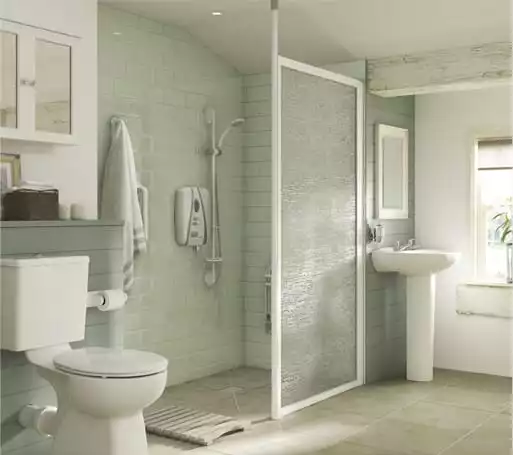
The Electric care shower is one of the most advanced thermostatic electric showers available. The easy one touch easy-to-press start/stop button makes for simple operating. The large LED read out with clear print helps to improve visibility and legibility of the available shower settings.
However, this award-winning electronic care shower also comes with a unique user-friendly remote control and safety temperature lock so you can pre-customise your bathing settings. The adjustable riser rail and long hose offer additional ease of use, and the adjustable easy clean head comes with a number of spray patterns, so you can find the best shower settings for you.
Check out The Kendal affordable walk-in shower range to view the Electric care shower.
Shower seats
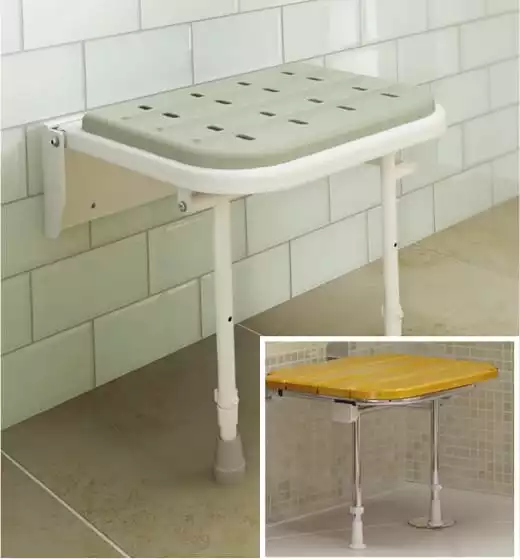
At Mobility Plus, we offer four types of shower seats to accompany your mobility bathroom. A shower seat can make your bathing experience even more relaxing, since it provides you with your own spot of luxury and tranquillity.
Compact fold up shower seat with grey pad
This grey pad shower seat (pictured above) is great for bathroom areas where space is limited. Its design provides stable support and the padded seat offers real comfort. When not in use the folding shower seat neatly moves up out-of-the-way, freeing up more space around your walk-in shower.
Standard fold up shower seat with arms and back
With its fold up design, arm and back support, this versatile shower seat meets a number of individual needs. This shower seat provides much needed support for individuals who have stability or mobility issues. The strong design prompts secure independent bathing and folds up out of the way, so you can maintain a spacious and luxurious mobility bathroom.
Fold up wooden seat with support legs
This shower seat design is made from ecologically friendly rubber wood and rust-proof stainless steel which creates a very stable and durable shower seat. The profiled edges are varnished for greater comfort and the shower seat is suitable or users up to 40 stone in weight.
Freestanding adjustable height shower stool
This shower seat is ideal for any active users with an unsteady balance or low stamina. The compact design is perfect to use in the shower, or at any other point throughout the home. The adjustable height settings make the stool versatile in practicality and functionality, while the simple yet durable design makes it easy to maintain and keep clean.
We are on hand to offer you more information on shower seats, and which solution is best for your bathing needs. Get in touch today or request a free brochure.
Grab rails
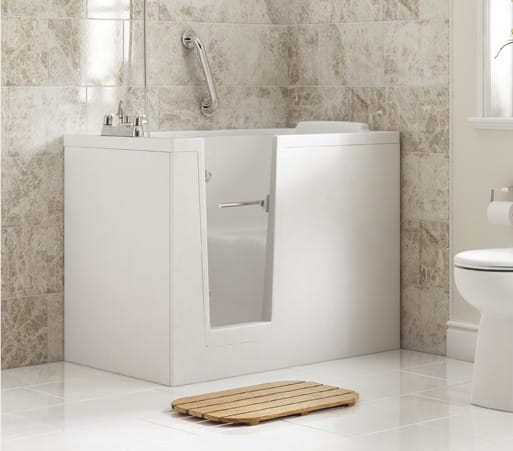
Grab rails are a hugely beneficial bathroom accessory to add to your walk-in shower or walk-in bath for additional safety and stability. We offer three types of grab rails, so you can find the best solution for your bathing and support needs.
Plastic fluted grab rails
Fluted surface grab rails provide additional grip and can support loads of up to 100 kg. The rail is positioned 59 mm away from the wall to ensure that the rail is easy to hold while also giving you space and flexibility of your body position while in use. This grab rail is made from high quality uPVC and is available in lengths of 300 mm, 450 mm, and 600 mm.
Stainless steel grab rails
This popular type of grab rail is made from high grade stainless steel and has a polished finish for a luxurious appearance that does not compromise on durability. The stainless steel grab rails are available in lengths of 300 m and 450 mm with a 32 mm diameter.
Contemporary stainless steel grab rails
This grab rail is similar to the stainless steel grab rail, but it differs in design, offering a contemporary appearance that is the perfect safety support for any modern bathroom. This design is available in lengths of 355 mm, 480 mm and 620 mm.
While the type of grab rail is important to the safety of your mobility bathroom, the position of the rail is just as essential. Check out our blog to learn more about grab rail positions for your mobility bathroom. If you have any questions about bathroom accessories we’re on hand to guide you through the best options for you. Get in touch today.














